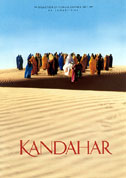
Movie Guru Rating:

Comment
on this review
| |

Unforgettable images enrich the remarkable Kandahar
by Lee Gardner
As Kandahar begins, Nafas (Nelofer Pazira), a female Afghan-Canadian journalist, is catching a ride to the Iran-Afghanistan border in a helicopter. Her sister, maimed by a land mine and still trapped under the oppressive Taliban regime, has written Nafas to say that she will commit suicide at the next solar eclipse—a few days hence. Nafas is desperate to get to Kandahar to help her sister but, as will happen throughout her journey, she must first endure an illuminating detour. As the chopper swoops toward an isolated Red Cross camp, the camera reveals a crowd of black-clad figures dashing out of tents and out toward the descending aircraft. Just before the 'copter passes overhead, you can make out that these running men are, in fact, all hobbling as fast as they can on crutches toward the pilot's cargo drop, which the next shot reveals: pairs of artificial legs drifting down toward the desert on parachutes, glinting like false hope in the wintry sun.
It is an extraordinary image, perhaps the most indelible moment in this latest effort from Iranian auteur Mohsen Makhmalbaf (Gabbeh), but it is far from the only one. Kandahar provides an unforgettable (and most timely) look into the cloistered world of Afghanistan under the Taliban. The film is a rough-hewn vision of almost unbelievable harshness, privation, and soul-defeat, but it is presented with such visual poetry and emotional verisimilitude that the viewer can't help but believe and be moved.
Kandahar is all the more extraordinary when one considers the story behind the scenes. The limpidly beautiful Pazira is, in fact, an Afghan woman who fled to Canada as a teenager and now works as journalist. Several years ago, she received a suicidal letter from a female friend who had remained behind in Afghanistan; Pazira tried to re-enter her native country and find her friend but didn't make it very far. Makhmalbaf heard about Pazira's story and crafted the fictional Kandahar around it, and her. And since the film's initial release in late 2001, reports have arisen that Hassan Tanta�, who portrays a sympathetic African-American exile Nafas happens across, may in fact be Daoud Salahuddin (née David Belfield), an American accused of assassinating an Iranian dissident in suburban Washington, D.C. in 1980.
But the film's strong and sometimes strange links with actual events pale beside the power of its depiction of conditions in pre-War-on-Terrorism Afghanistan. Disguised under a body-covering burqa and reciting ruminations into her handy tape recorder on the sly, Nafas serves as the viewer's Candide-like guide to this worst of all possible worlds. As she proceeds from an Iranian border village Nafas encounters cruel bandits; a woman who trains little refugee girls to avoid the dolls strewn on minefields; an Afghan religious school where the only text is the Quran and the only lesson is warrior rhetoric; a doctor (Tanta�) permitted by Taliban interpretation of Islamic law to only examine his female patients through a small hole in a curtain; and some of the millions of Afghans who have lost legs to mines, many of whom must wait years for artificial limbs to drop from the skies.
All the while, Nafas risks exposure as an unmarried woman traveling alone. Even Khak (Sadou Teymouri), the young boy she enlists as a guide, has the power to destroy her. And she still has her sister to save, if she can.
The amateur cast, semi-improvised script, and obviously rugged shooting conditions on the actual Iran-Afghanistan border contribute to several shaky scenes, but on the whole, writer/producer/director/editor Makhmalbaf and cinematographer Ebraham Ghafouri work miracles, not least by deftly maintaining the leitmotif of female oppression under the Taliban. Other than the little refugee girls, Nafas is the only woman to show her face on-screen; the many other women who pass Ghafouri's lenses do so only under many-colored burqas, simultaneously colorful and lonely figures.
Makhmalbaf offers only glimpses of these women—snatches of conversation or shots of dirty hands applying nail polish and desperately grabbing cheap bracelets at a sort of ad-hoc roadside beauty boutique—but their plight, personified by Nafas' sister, gives this sometimes meandering film an underlying urgency, even suspense. By the film's seemingly abrupt but unforgettable ending, the question isn't so much whether Nafas can save her sister, but whether she can avoid dooming herself.

March 28, 2001 * Vol. 12, No. 13
© 2000 Metro Pulse
|